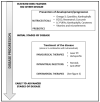Pharmacotherapy and Nutritional Supplements for Neovascular Eye Diseases
- PMID: 37512145
- PMCID: PMC10383223
- DOI: 10.3390/medicina59071334
Pharmacotherapy and Nutritional Supplements for Neovascular Eye Diseases
Abstract
In this review, we aim to provide an overview of the recent findings about the treatment of neovascular retinal diseases. The use of conventional drugs and nutraceuticals endowed with antioxidant and anti-inflammatory properties that may support conventional therapies will be considered, with the final aim of achieving risk reduction (prevention) and outcome improvement (cooperation between treatments) of such sight-threatening proliferative retinopathies. For this purpose, we consider a medicinal product one that contains well-defined compound(s) with proven pharmacological and therapeutic effects, usually given for the treatment of full-blown diseases. Rarely are prescription drugs given for preventive purposes. A dietary supplement refers to a compound (often an extract or a mixture) used in the prevention or co-adjuvant treatment of a given pathology. However, it must be kept in mind that drug-supplement interactions may exist and might affect the efficacy of certain drug treatments. Moreover, the distinction between medicinal products and dietary supplements is not always straightforward. For instance, melatonin is formulated as a medicinal product for the treatment of sleep and behavioral problems; at low doses (usually below 1 mg), it is considered a nutraceutical, while at higher doses, it is sold as a psychotropic drug. Despite their lower status with respect to drugs, increasing evidence supports the notion of the beneficial effects of dietary supplements on proliferative retinopathies, a major cause of vision loss in the elderly. Therefore, we believe that, on a patient-by-patient basis, the administration of nutraceuticals, either alone or in association, could benefit many patients, delaying the progression of their disease and likely improving the efficacy of pharmaceutical drugs.
Keywords: drugs; eye; neo-angiogenesis; nutraceuticals; retina.
Conflict of interest statement
The authors declare no conflict of interest.
Figures





Similar articles
-
Prevalence of polypharmacy, polyherbacy, nutritional supplement use and potential product interactions among older adults living on the United States-Mexico border: a descriptive, questionnaire-based study.Drugs Aging. 2009;26(5):423-36. doi: 10.2165/00002512-200926050-00006. Drugs Aging. 2009. PMID: 19552494
-
Prevention of Cardiovascular Diseases with Anti-Inflammatory and Anti- Oxidant Nutraceuticals and Herbal Products: An Overview of Pre-Clinical and Clinical Studies.Recent Pat Inflamm Allergy Drug Discov. 2018;12(2):145-157. doi: 10.2174/1872213X12666180815144803. Recent Pat Inflamm Allergy Drug Discov. 2018. PMID: 30109827 Review.
-
The role of cellular micronutrient analysis, nutraceuticals, vitamins, antioxidants and minerals in the prevention and treatment of hypertension and cardiovascular disease.Ther Adv Cardiovasc Dis. 2010 Jun;4(3):165-83. doi: 10.1177/1753944710368205. Epub 2010 Apr 16. Ther Adv Cardiovasc Dis. 2010. PMID: 20400494 Review.
-
Defining 'nutraceuticals': neither nutritious nor pharmaceutical.Br J Clin Pharmacol. 2017 Jan;83(1):8-19. doi: 10.1111/bcp.12935. Epub 2016 Apr 25. Br J Clin Pharmacol. 2017. PMID: 26991455 Free PMC article. Review.
-
Nutrients for Prevention of Macular Degeneration and Eye-Related Diseases.Antioxidants (Basel). 2019 Apr 2;8(4):85. doi: 10.3390/antiox8040085. Antioxidants (Basel). 2019. PMID: 30986936 Free PMC article. Review.
Cited by
-
A Personal Scientific Journey in Ophthalmology: Twenty-Five Years of Translating Research into Novel Therapies.Pharmaceuticals (Basel). 2025 Jun 12;18(6):883. doi: 10.3390/ph18060883. Pharmaceuticals (Basel). 2025. PMID: 40573278 Free PMC article. Review.
-
Cell and molecular targeted therapies for diabetic retinopathy.Front Endocrinol (Lausanne). 2024 Jun 14;15:1416668. doi: 10.3389/fendo.2024.1416668. eCollection 2024. Front Endocrinol (Lausanne). 2024. PMID: 38948520 Free PMC article. Review.
-
Exploring gellan gum-based hydrogels for regenerating human embryonic stem cells in age-related macular degeneration therapy: A literature review.Regen Ther. 2024 Jun 10;26:235-250. doi: 10.1016/j.reth.2024.05.018. eCollection 2024 Jun. Regen Ther. 2024. PMID: 38966602 Free PMC article. Review.
-
Editorial to the Special Issue "Retinopathies: A Challenge for Early Diagnosis, Innovative Treatments, and Reliable Follow-Up".Medicina (Kaunas). 2025 Apr 3;61(4):662. doi: 10.3390/medicina61040662. Medicina (Kaunas). 2025. PMID: 40282953 Free PMC article.
-
A promising case of preclinical-clinical translation: β-adrenoceptor blockade from the oxygen-induced retinopathy model to retinopathy of prematurity.Front Physiol. 2024 Jun 13;15:1408605. doi: 10.3389/fphys.2024.1408605. eCollection 2024. Front Physiol. 2024. PMID: 38938747 Free PMC article. Review.
References
-
- DeFelice S.L. The nutraceutical revolution: Its impact on food industry R&D. Trends Food Sci. Technol. 1995;6:59–61.
-
- Horowitz A., Brennan M., Reinhardt J.P. Prevalence and risk factors for self-reported visual impairment among middle-aged and older adults. Res. Aging. 2005;27:307–326. doi: 10.1177/0164027504274267. - DOI
-
- Johnson G.J., Minassian D.C., Weale R.A., West S.K., editors. Epidemiology of Eye Disease. 3rd ed. World Scientific; Singapore: 2012.
Publication types
MeSH terms
Substances
LinkOut - more resources
Full Text Sources
Medical

